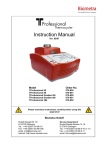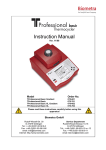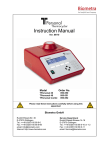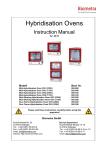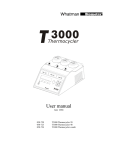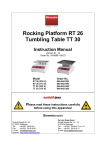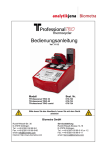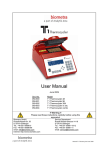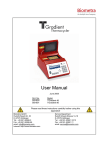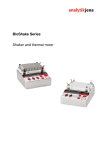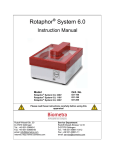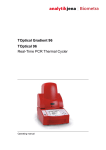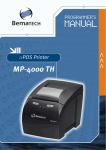Download TProfessional TRIO user manual
Transcript
Instruction Manual Ver. 11/12 Model Ord. No. TProfessional TRIO 30 TProfessional TRIO 48 TProfessional TRIO combi 070-720 070-723 070-724 Please read these instructions carefully before using this apparatus! Biometra GmbH Rudolf-Wissell-Str. 30 D-37079 Göttingen Tel.: +49 551-50686-0 Fax: +49 551-50686-66 email: [email protected] Internet: http://www.biometra.com Service Department Rudolf-Wissell-Strasse 14-16 D-37079 Göttingen Tel.: +49 551-50881-10/12 Fax: +49 551-50881-11 email: [email protected] This document describes the state at the time of publishing. It needs not necessarily agree with future versions. Subject to change! 2 Instruction Manual TProfessional TRIO 12/2011 Contents 1 Introduction......................................................................................................................... 6 1.1 Field of Applications ..................................................................................................... 6 1.2 Special features ............................................................................................................ 6 1.2.1 Three independent Thermocyclers in one instrument .......................................... 6 1.2.2 Easy programming................................................................................................ 6 1.2.3 High speed............................................................................................................ 6 1.2.4 Smart lid technology ............................................................................................. 7 1.2.5 USB port ............................................................................................................... 7 1.3 Technical specifications TProfessional TRIO Thermocycler ........................................ 8 1.4 Legal Notes .................................................................................................................. 9 1.4.1 PCR License – Legal Disclaimer .......................................................................... 9 1.4.2 Copyright .............................................................................................................. 9 1.4.3 Liability.................................................................................................................. 9 1.4.4 Meaning of the instructions................................................................................... 9 2 Safety and Warning Notices ............................................................................................ 10 2.1 Definition of Symbols .................................................................................................. 10 2.2 General Safety Instructions ........................................................................................ 10 3 Installation......................................................................................................................... 13 3.1 Content of delivery...................................................................................................... 13 3.2 Unpack and check ...................................................................................................... 13 3.3 Installation conditions ................................................................................................. 13 3.4 Operation Voltage....................................................................................................... 14 3.5 Initial self test.............................................................................................................. 14 4 Operating elements .......................................................................................................... 16 4.1 The TProfessional TRIO Thermocycler front view...................................................... 16 4.2 The TProfessional TRIO Thermocycler rear view....................................................... 17 4.3 The TProfessional TRIO control panel ....................................................................... 17 4.4 The High Performance Smart Lid (HPSL) .................................................................. 18 5 Operating........................................................................................................................... 19 5.1 The TProfessional TRIO user interface ...................................................................... 19 5.1.1 TProfessional TRIO menu buttons ..................................................................... 19 5.1.2 TProfessional TRIO softkeys .............................................................................. 19 5.1.3 Log in menu ........................................................................................................ 20 5.1.4 Block menu ......................................................................................................... 20 5.1.5 System menu...................................................................................................... 21 5.1.6 Program menu .................................................................................................... 21 5.2 TProfessional TRIO software...................................................................................... 22 5.2.1 Log in .................................................................................................................. 22 5.2.2 Create new user account.................................................................................... 24 5.2.3 Supervisor Log in................................................................................................ 24 5.2.4 Delete User......................................................................................................... 25 5.3 Create program .......................................................................................................... 25 5.3.1 Create program from template............................................................................ 25 Instruction Manual TProfessional TRIO 12/2011 3 5.3.2 Create program without template ........................................................................26 5.3.3 Set lid pre-heating mode .....................................................................................26 5.3.4 Set lid temperature ..............................................................................................27 5.3.5 Enter step temperature and time .........................................................................27 5.3.6 Set loop ...............................................................................................................28 5.3.7 Cool below ambient temperature ........................................................................29 5.3.8 Program Pause ...................................................................................................29 5.3.9 Save program ......................................................................................................29 5.3.10 Set temperature optimisation step.......................................................................32 5.4 Edit programs ..............................................................................................................34 5.4.1 Insert program step .............................................................................................34 5.4.2 Delete program step ............................................................................................36 5.4.3 Copy program......................................................................................................37 5.4.4 Delete program....................................................................................................38 5.4.5 Editing programs in the graphical mode ..............................................................40 5.5 Change program options.............................................................................................40 5.5.1 Heating and cooling rate .....................................................................................41 5.5.2 Time increment Æ Δt(s).......................................................................................42 5.5.3 Temperature increment or decrement Æ ΔT(°C) ................................................42 5.6 Run program ...............................................................................................................43 5.6.1 Select program for start from user directories .....................................................43 5.6.2 Quick start programs from the block menu..........................................................45 5.6.3 View program prior to start ..................................................................................46 5.6.4 Display during operation......................................................................................47 5.6.5 Pause Program during run ..................................................................................49 5.6.6 Continue program................................................................................................50 5.6.7 Skip program step ...............................................................................................50 5.7 Stop program...............................................................................................................52 5.7.1 Stop program from a pause.................................................................................52 5.8 USB functions..............................................................................................................53 5.8.1 Connect USB drive to Thermocycler ...................................................................53 5.8.2 Access USB drive................................................................................................53 5.8.3 Delete program in folder USB drive.....................................................................55 5.8.4 Copy program from USB drive ............................................................................55 5.8.5 Copy program to USB drive.................................................................................56 5.8.6 Maximum number of programs on the USB drive ...............................................57 6 System settings.................................................................................................................59 6.1 User configuration .......................................................................................................59 6.1.1 Set language .......................................................................................................59 6.1.2 Change individual PIN .........................................................................................60 6.1.3 Delete account ....................................................................................................60 6.2 System configuration...................................................................................................61 6.2.1 Configure beep....................................................................................................61 6.2.2 Configure display contrast ...................................................................................61 6.2.3 Set time and date ................................................................................................62 6.2.4 Defragment memory............................................................................................62 6.2.5 Screen saver .......................................................................................................63 6.3 System info..................................................................................................................63 6.3.1 System info..........................................................................................................64 6.3.2 View run log files of the last nine runs .................................................................64 4 Instruction Manual TProfessional TRIO 12/2011 6.4 Service........................................................................................................................ 66 6.4.1 View log files of Power on self test ..................................................................... 66 6.4.2 Execute block extended self test ........................................................................ 66 6.4.3 View log files from extended self test ................................................................. 67 6.4.4 View Error log files.............................................................................................. 69 6.4.5 Create service info file for the Biometra Service Department ............................. 69 6.5 How to contact Biometra ............................................................................................ 69 6.6 Supervisor system configuration................................................................................. 70 6.6.1 Change user PIN ................................................................................................ 70 6.6.2 Delete user account............................................................................................ 71 6.6.3 Change supervisor PIN....................................................................................... 71 6.6.4 Set boot language............................................................................................... 72 6.6.5 Delete all user accounts ..................................................................................... 72 7 Short manual..................................................................................................................... 74 8 Trouble shooting .............................................................................................................. 79 8.1 Slow heating and cooling............................................................................................ 79 8.2 Autorestart .................................................................................................................. 79 8.3 Restart due to unrecognised power failure ................................................................. 79 8.4 Adaptation of protocols from other cyclers ................................................................. 79 8.5 Releasing wheel in case of blocked lid ....................................................................... 79 9 Maintenance and repair ................................................................................................... 81 9.1 Cleaning and Maintenance ......................................................................................... 81 9.2 Servicing and repair.................................................................................................... 81 9.3 Firmware update......................................................................................................... 81 9.4 Replacement of spare parts ....................................................................................... 81 10 Accessories ...................................................................................................................... 82 10.1 Plasticware ................................................................................................................. 82 11 Service............................................................................................................................... 83 11.1 Instructions for return shipment .................................................................................. 83 11.2 Packing of the Thermocycler ...................................................................................... 84 12 Equipment Decontamination Certificate ........................................................................ 85 13 Note for the disposal of electric / electronic waste....................................................... 87 14 EU – Konformitätserklärung / EU - Declaration of Conformity .................................... 88 15 Warranty ............................................................................................................................ 89 16 Subject Index .................................................................................................................... 90 Instruction Manual TProfessional TRIO 12/2011 5 1 Introduction 1.1 Field of Applications The Biometra TProfessional TRIO is a Thermocycler licensed for PCR applications (research use only) and intended to be used for performing polymerase chain reactions. The instrument continues the Biometra line of triple block Thermocyclers and combines the intuitive user software of the TProfessional family with a completely new hardware structure that delivers highest performance. Due to an improved air stream design the exhaust is now located at the rear and higher temperature uniformity and heating and cooling rates are achieved. For easy administration the TProfessional TRIO offers versatile USB functions. The result is a high-end, easy to use Thermocycler with excellent technical specifications. 1.2 1.2.1 Special features Three independent Thermocyclers in one instrument The TProfessional TRIO Thermocycler offers three independent blocks in one housing thus different independent protocols can be run at the same time. Moreover by the new temperature optimisation step (TOS), that makes use of the multiblock function of the instrument, program steps, delivering three different annealing temperatures, can be created easily. This makes the TProfessional TRIO Thermocycler the perfect instrument for laboratories with the demand for high flexibility and the need to often optimise new PCR-protocols. With a maximum capacity of 3 x 48 wells the TProfessional TRIO also offers high throughput in parallel operation. The TProfessional TRIO Thermocycler is available in three different block versions for 0.2 ml tubes, 0.5 ml tubes or both in the combi block. 1.2.2 Easy programming The TProfessional TRIO Thermocycler offers the intuitive TProfessional software with easy spreadsheet programming philosophy. New programs are easily created in a well arranged screen that avoids the need to toggle between different windows. This makes the creation of new or editing existing programs fast and easy. One touch leads from the spreadsheet to an alternative graphical programming mode. Four softkeys directly below the display offer quick access to all functions needed in the individual context and four menu buttons above the display to the main menus. For easy retrieval, programs can be stored in 30 individual subdirectories (optionally password protected). By the administrator function the accumulation of unused programs or user directories can be managed to keep the memory content up-to date. Keyboard and display are arranged at an angle to ensure reflection-free viewing and ergonomic programming. 1.2.3 High speed By the elegant housing with improved air stream design and a completely new hardware environment the TProfessional TRIO achieves higher heating and cooling rates and better temperature uniformity. High ramping rates provide both short experimental times and increased specificity. The instrument works quietly and consumes little power, which in turn leads to low heat emission and by the compact footprint it saves valuable bench space. 6 Instruction Manual TProfessional TRIO 12/2011 1.2.4 Smart lid technology The TProfessional TRIO Thermocyclers heated lids prevent condensation and provide reliable contact between samples and thermoblock. The lids are powered by Biometra‘s well known Smart Lid technology with integrated clutch mechanism which automatically limits the lid pressure applied to the plasticware and thus saves tubes from damage. In addition by formation of a homogeneous air cushion an even temperature distribution between the samples is ensured, significantly improving temperature uniformity. This also ensures reproducible conditions amongst different PCR runs. The temperature of the independently working lids can be set individually in a range between 30 and 99°C. This ensures optimal conditions also for other applications as PCR like e.g. enzymatic restriction reactions. With one press on the front button, the lids gently swing open and arrest in their end position. In combination with the now easier to access blocks this provides a maximum of convenience to the customer. 1.2.5 USB port By using an USB stick protocols can be exchanged between instruments. Therefore by the USB functions it is very easy to synchronize the memory contents of instruments. Instruction Manual TProfessional TRIO 12/2011 7 1.3 Technical specifications TProfessional TRIO Thermocycler Order number 070-720 070-723 070-724 TProfessional TRIO 30 TProfessional TRIO 48 TProfessional TRIO combi 3 blocks for 30 x 0.5ml tubes each 3 blocks for 48 x 0.2ml tubes or 48 well microplates or 6 x strips of 8 each 3 combi blocks for 18 x 0.5ml tubes** or 48 x 0.2ml tubes, or 48 well microplates or 6 x strips of 8 Max. Heating rate* 4.0 °C/sec 5.0 °C/sec 3.0 °C/sec Avg. Heating rate* 3.6 °C/sec 4.2 °C/sec 2.7 °C/sec * 3.6 °C/sec 4.5 °C/sec 2.7 °C/sec * 3.2 °C/sec 3.8 °C/sec 2.4 °C/sec Capacity Max. Cooling rate Avg. Cooling rate Temperature Uniformity* ± 0.6 °C at 95 °C ± 0.3 °C at 70 °C ± 0.2 °C at 55 °C Temperature range 3°C to 99°C Multiblock tool Control accuracy Blocks Software Program memory Display Auto restart after power failure Cool samples at 4°C Heated lid Lid temperature range Power consumption Noise emission Interfaces Dimensions (W x D x H) Weight Temperature Optimisation Step (TOS) 0.1°C Aluminium Toggle between easy spreadsheet and graphical mode, adjustable ramp rates, time and temperature increments, extended self test, service info files, USB functions. 30 individual subdirectories, 350 average programs ¼ VGA screen, 320 x 240 pixel Yes Yes High Precision Smart Lid for optimal lid pressure and excellent temperature uniformity 30°C to 99°C 1000 Watt Very low 1x USB A Port, 1x USB B Port 30 cm x 41 cm x 25 cm 17.3 kg Working 5 – 35°C, 70% relative humidity conditions * According to Biometra standard procedure. ** Capacity increases to 35 x 0.5 ml tubes by use of small cap tubes 8 Instruction Manual TProfessional TRIO 12/2011 1.4 Legal Notes 1.4.1 PCR License – Legal Disclaimer Purchase of a Biometra Thermocycler conveys a limited non-transferable immunity from suit for the purchaser’s own internal research and development and applied fields other than human in vitro diagnostics under one or more of US Patents Nos. 5,038,852, 5,656,493, 5,333,675, 5,475,610, and 6,703,236, or corresponding claims in their non-US counterparts, owned by Applera Corporation. No right is conveyed expressly, by implication or by estoppel under any patent claim, reagents, kits, or methods such as 5´ nuclease methods, or under any other apparatus or system claim, including but not limited to US Patent No. 6,814,934 and its non-US counterparts, which describe and claim thermal cyclers capable of real-time detection. Further information on purchasing licenses may be obtained by contacting the Director of Licensing, Applied Biosystems, 850 Lincoln Centre Drive, Foster City, California 94404, USA. Biometra biomedizinische Analytik GmbH Rudolf Wissell Str. 30 37079 Goettingen, Germany 1.4.2 Copyright All rights reserved. It is not allowed to copy and publish the manual or parts of it in any form as copies, micro film or other methods without a written authorisation from Biometra. Biometra is pointing out that applied company and brand names are usually protected trade marks. 1.4.3 Liability Biometra is not liable for damages and injuries caused by use not considering these operating instructions in parts or completely. 1.4.4 Meaning of the instructions Biometra recommends that you first read these instructions carefully. This operation instruction is part of the product and should be kept over the full life-time of the instrument. It should also be forwarded to subsequent owners and users. Make sure that additions and updates are inserted into the operation instructions. Instruction Manual TProfessional TRIO 12/2011 9 2 Safety and Warning Notices 2.1 Definition of Symbols Symbol Definition Caution! Refer to instruction manual! Danger! High voltage! Fragile! Danger! Hot surface! 2.2 General Safety Instructions Please read this manual carefully before starting operation of the TProfessional TRIO Thermocycler. The TProfessional TRIO Thermocycler is intended for sample incubation at varying temperatures. • General safety precautions for laboratory work must be observed when working with the TProfessional TRIO Thermocycler. • The TProfessional TRIO does not produce a sound power level that could be hazardous for the user. The thermoblock and the heated lid will reach high temperatures during operation. Both thermoblock and heated lid can burn you. Rapid heating of the thermoblock can cause liquids to boil explosively. Always wear safety goggles during operation. Close the lid before starting a program. Do not heat samples without having the lid locked securely. Be aware that samples are reaching high temperatures. Do not touch or open hot tubes or microplates because hot liquid may quickly spill out. Do not touch the heated lid. Use only suited plastic ware in the TProfessional TRIO Thermocycler. Tubes and plates must show good fit when placed in the thermoblock. Only use tubes that are suited for high temperatures (tight lids). 10 Instruction Manual TProfessional TRIO 12/2011 The TProfessional TRIO Thermocycler contains no user serviceable parts. Do not open the instruments housing. Service and repair may only be carried out by the Biometra Service department or otherwise qualified technical personal. Do not use the instrument when damages of the housing, block, cable or other parts are visible. Prior to connecting the unit to the power source please ensure that the voltage selector at the bottom of the instrument is set to the required voltage. Make sure that the main supply voltage is in accordance with the label above the power connection (see section 4.2) Unplug the power cable before you open the TProfessional TRIO Thermocycler. Danger of electric shock! Make sure that the appliance connector and the plug of the supply cord are accessible, so you can separate the instrument from the mains. Connect the TProfessional TRIO Thermocycler to a grounded socket. When only few samples are put in the block place additional tubes in the four corner positions. This is to evenly distribute the lid pressure and prevents single tubes from excessive pressure. Use of few tubes may result in damage of the tubes by excessive pressure. Appropriate safety regulations must be observed when working with infectious, pathogenic or radioactive material. Ask the responsible local safety inspector for details. The TProfessional TRIO Thermocycler must not be used with explosive, flammable or volatile liquids. Do not place fingers between lid and housing when opening or closing the lid. Before opening of the lid, release lid pressure (see section 4.4) It is not necessary to apply oil into the opening of the block in order to improve the heat transfer between the block and the sample tubes. If you still decide to use oil, do not use silicon oil. Mineral oil may be used. Ensure that both the rear and bottom ventilation slits not clogged by dust or other material. Danger of overheating! Let equilibrate the TProfessional TRIO Thermocycler to room temperature before starting operation. There must be sufficient distance between the ventilation slots on the rear of the Thermocycler and a wall or another instrument (min 10 cm). Danger of overheating! This instrument is designed and certified to meet EN 61010-1 safety standards. It should not be modified or altered in any way. Alteration Instruction Manual TProfessional TRIO 12/2011 11 of this instrument will void the warranty, void the EN61010-1 certification, and create a potential safety hazard. Place the TProfessional TRIO Thermocycler on a stable, non flammable surface in a dry, safe environment. For details see working conditions in table “Technical specifications” (see chapter 1.3). Do not use alcohol (e.g. methanol, ethanol), organic solvents or abrasives to clean the instrument. For transports always use the original Biometra box. 12 Instruction Manual TProfessional TRIO 12/2011 3 Installation 3.1 Content of delivery 1) 2) 3) 4) Thermocycler Mains connector Manual Short Manual Please keep the original transport box for return shipment in case of servicing. The TProfessional TRIO shipping box provides a specially developed system for contact-free transport of this electronic device. 3.2 Unpack and check Unpack and carefully examine the instrument. Report any damage to Biometra. Do not attempt to operate this device if physical damage is present. Please keep the original packing material for return shipment in case of service issues !! Attention !! Please fill out and send back the warranty registration card. This is important for you to claim full warranty. 3.3 Installation conditions • Place the TProfessional TRIO Thermocycler on a stable surface in a dry, safe environment. For details see working conditions in table “Technical specifications” (see chapter 1.3). • Let equilibrate the TProfessional TRIO Thermocycler to room temperature before starting operation (1 to 6h). • Make sure that the appliance connector and the plug of the supply cord are accessible, so you can separate the instrument from the mains. • Make sure that the ventilation slots on the bottom and the rear are not obstructed (see section 4.2). Make sure that there is no object underneath the thermocycler that may block the ventilation slots at the bottom (e.g. a piece of paper etc.) • There must be sufficient distance between the ventilation slots at the rear of the Thermocycler and a wall or another instrument (min 10 cm). Ensure that both the side and bottom ventilation slits of the rear and bottom of the instrument are unobstructed. Insufficient ventilation can cause overheating of the instrument. Instruction Manual TProfessional TRIO 12/2011 13 • Make sure that the main supply voltage is in accordance with the label above the power connection (see section 3.4) • Connect the TProfessional TRIO Thermocycler to a grounded socket. Prior to connecting the unit to the power source please ensure that the voltage selector at the back side of the instrument is set to the required voltage. Danger of electric shock! Unplug the power cable before you open the TProfessional TRIO Thermocycler. • The display contrast can be adjusted to local light conditions (6.2.2). 3.4 Operation Voltage Important: Prior to connecting the TProfessional TRIO to the mains, make sure that the setting of the Voltage selector is in accordance with your mains Voltage. The TProfessional TRIO Thermocycler can operate at 100, 115 or 230 Volt. The operation Voltage is shown on the Voltage selector which is located at the instrument bottom. To change operation Voltage of the TProfessional TRIO, switch off the instrument and disconnect the mains plug. Use a coin or another round shape item to turn the adjustment slot of the Voltage selector to the new Voltage. Instrument bottom Instrument backside Voltage indicator Mains plug Fuses 110 Fuses 11 5 230 Adjustment slot Power switch 1 2 3.5 Initial self test After switching on the TProfessional TRIO the serial number of the instrument and the software version are displayed. 14 Instruction Manual TProfessional TRIO 12/2011 A log file of the power on self test is stored in the Thermocycler memory (see section 6.4.1). Instruction Manual TProfessional TRIO 12/2011 15 4 Operating elements 4.1 The TProfessional TRIO Thermocycler front view 16 Instruction Manual TProfessional TRIO 12/2011 4.2 The TProfessional TRIO Thermocycler rear view 4.3 The TProfessional TRIO control panel Instruction Manual TProfessional TRIO 12/2011 17 4.4 The High Performance Smart Lid (HPSL) To achieve optimum pressure on the tubes the TProfessional TRIO is equipped with a height adjustable heated lid. Close the lid: After the samples have been placed in the block close the lid. Turn the wheel clockwise until you hear a clicking noise. In this mode the pressure will not increase further, even when you keep on turning the wheel. Note: The pressure of the lid has been optimized for a fully loaded block. If only very few tubes are loaded to the block you should place dummy tubes in the four corner positions to avoid damage of tubes by excessive pressure. Open the heated lid: First: Release pressure by turning the wheel counter clockwise. As soon as there is no more resistance the pressure has been released. Then: Now you can open the lid with the knob. Important: The lid should not be opened under pressure because this leads to damage of the locking mechanism. 18 Instruction Manual TProfessional TRIO 12/2011 5 Operating 5.1 The TProfessional TRIO user interface The TProfessional TRIO user interface provides four menu buttons above the screen and four softkeys below the screen 5.1.1 TProfessional TRIO menu buttons The four menu buttons allow quick access to the TProfessional TRIO main menus. These are: • • • • Login /out System Block Program menu menu menu menu The active menu is indicated by a graphical link to the respective menu button. The example shows Program menu is active. The four menu buttons are permanent and always have the same function. This is in contrast to the softkeys. The softkey functions change depending on the current software menu. 5.1.2 TProfessional TRIO softkeys Below the display there are four softkeys. Instruction Manual TProfessional TRIO 12/2011 19 In contrast to the menu buttons, the softkeys have changing functionalities, which are shown in the above display line. 5.1.3 Log in menu To enter the Log In menu, press the menu button [Log in/out] above the display. When the instrument is switched on, the log in screen is displayed. To use the instrument a user has to be selected. Alternatively, a new user can be created. 5.1.4 Block menu To enter the Block menu, press the menu button [Block] above the display. The Block menu shows the current status of each of the three blocks. Each block can be active with a program running or free. 20 Instruction Manual TProfessional TRIO 12/2011 5.1.5 System menu To enter the System menu, press the menu button [System] above the display. The System menu allows global settings and provides information about the instrument. The power on self test log files can be retrieved and service files generated, a detailed description of this menu is shown in section 6. 5.1.6 Program menu To enter the Program menu, press menu button Program above the display. In the Program menu, existing programs can be edited or new programs can be created. Each user has its own user directory where individual programs are saved. Programs from other user directories can be used or copied but not modified. Instruction Manual TProfessional TRIO 12/2011 21 5.2 TProfessional TRIO software The TProfessional TRIO Thermocycler features easy spread sheet programming. This means that all program parameters are entered into a simple central spreadsheet without the need to toggle between different screens. Four cursor keys provide easy navigation within the software. The cursor keys LEFT and RIGHT have additional functions as described below: The right cursor key moves the cursor to the next field. This cursor can also be used to complete data entry. By pressing the right cursor key settings will be taken over and the cursor moves to the next field. In the file directory, this key moves to cursor forward to the next (lower) level. The left cursor key moves the cursor back to the previous field. In most screens this cursor is equivalent to the [Back] softkey on the control panel (see chapter 4.3). In the file directory, this key moves the cursor back to the higher level. 5.2.1 Log in The TProfessional TRIO manages up to 30 individual users. For each user a directory is created where programs are stored. Programs from other directories (i.e. users) can be read and copied but not modified. This allows to use all programs that are in the cycler memory, but to write only in the own user directory. Each user is identified by his user name (max. 15 digits) and initials (2-3 letters). Press menu button [Log in/out] above the display. A list of users is shown: Select user with cursor keys or enter first initial. The cursor jumps to the first account starting with this letter. 22 Instruction Manual TProfessional TRIO 12/2011 Press softkey [Log in] and (if the directory is PIN-code protected) enter the PIN-code. Confirm PIN with softkey [PIN-code OK]. Then the currently logged-in user is shown: To proceed with editing or running a program, select the menu button [Program] or [Block] above the display. Instruction Manual TProfessional TRIO 12/2011 23 5.2.2 Create new user account Press menu button [Log in/out] above the display. To create a new user account press softkey [New User]. Enter your name and 2-3 initials. Enter a personal identification number (PIN) consisting of 1-7 digits. For security reasons, you are requested to repeat the entry of your PIN. Note: PIN entry is optional. If no password protection is wanted, just confirm with [User-Data OK]. However, if no PIN is entered, you account containing all of your programs can be modified by unauthorized personal. Note: Your PIN can be changed any time in the System menu (see section 6.6.1). 5.2.3 Supervisor Log in Only the supervisor is authorized to change global instrument settings. This includes update of firmware and the deletion of user accounts (see section 6.6). 24 Instruction Manual TProfessional TRIO 12/2011 To log in as supervisor, press the [Log in/out] menu button above the display. Press softkey [Supervisor Log in], enter supervisor PIN and confirm with [PIN-code OK]. The default supervisor PIN is 000 000 0 (do not enter blanks). 5.2.4 Delete User Once logged in, you can delete your own account in the System menu (see section 6.1.3). In addition, any user can be deleted by the supervisor. To delete a user, log in as supervisor (see section 6.6.2) and select menu option “delete user”. Choose the user account you would like to delete and confirm with [OK]. Note: By deleting a user account all programs in the referring user directory will be deleted. It is therefore recommended to safe the programs in a different directory prior to deleting a user account. 5.3 Create program At Thermocyclers of the TProfessional series programs can be created in two ways. Preinstalled program examples may be used (see chapter 5.3.1) or new programs without a template created (see chapter 5.3.2). 5.3.1 Create program from template Log in to your personal user directory and press menu button [Program] above the display to enter the TProfessional TRIO program menu. The directory “Biometra Shared” contains several pre-installed protocols for different PCR applications. Press [Open Directory] to open the directory „Biometra Shared“. Choose a suitable program by navigating with the cursor keys or enter the corresponding program number. Protocols may be started directly from the Biometra Shared directory or may be copied to the respective user directory and edited (see chapter 5.4.3) Note: Please always, before starting a template protocol, check the single steps and adapt details (times, temperatures, loops, temperature- and time-increments) according to the required PCR conditions respectively. Biometra will not be liable if the PCR does not work if necessary adjustments have not been programmed. Instruction Manual TProfessional TRIO 12/2011 25 Note: The directory is protected by a PIN-Code. The default PIN for the directory “Biometra Shared” is 0000. 5.3.2 Create program without template Press menu button [Program] above the display (see chapter 5.1) to enter the TProfessional TRIO Program menu. Press softkey [New Program]. The easy programming spreadsheet opens (see chapter 5.3.3). 5.3.3 Set lid pre-heating mode Before the program starts the lid can be pre-heated. The pre-heating ensures the formation of a homogeneous tempered air cushion between the samples and avoids evaporation during the initial heating phase. Note: During the pre-heating phase of the lid, the block is held constant at 25°C. Note: After reaching the set lid temperature, there is a 40 second equilibration phase before the block starts. Note: The default setting, which is recommended for most applications, is pre-heating ON. 26 Instruction Manual TProfessional TRIO 12/2011 However, if the program should already start while the lid is heating up, set the pre-heating mode OFF using softkey [Preheat ON/OFF]. Confirm the settings for the heated lid with [Enter] or step to the next field with the right cursor key. 5.3.4 Set lid temperature Note: Thanks to the design of the High Performance Smart Lid, lower lid temperatures can be used for thermocycling than in the past. Thanks to the lower lid temperature a higher temperature uniformity between samples is be achieved. The recommended lid temperature is 99.0°C. Enter temperature and confirm with [Enter] or step to the next field with the right cursor key. 5.3.5 Enter step temperature and time Use cursor keys to navigate within the programming table. Note: Each setting is confirmed with [Enter]. The cursor moves automatically to the next field. Alternatively, you can confirm a value by moving forward with the cursor keys. Instruction Manual TProfessional TRIO 12/2011 27 Enter temperature for the first step and press [Enter]. In the next column you can enter the time for this temperature: Note: Minutes and seconds can be separated by “dot”, but this is optional. You can also enter the digits one after the other. Example: To set 2 minutes, 30 seconds enter “2”, “3”, “0”. Subsequently 2:30 [m:s] will be displayed in the programming spreadsheet. Note: For Biometra Thermocyclers a dot can be used as a shortcut to program minutes. Example: To set 2 minutes enter “2”, “•”. Subsequently 2:00 [m:s] will be displayed in the programming table 5.3.6 Set loop Note: In general, loops are entered in the LAST STEP of the loop. A loop is defined by selecting the FIRST STEP in the loop plus the number of back loops. Enter the number of the first step within the loop in the column “goto” and confirm with [Enter]. Enter the number of back loops in the column “loops”. 28 Instruction Manual TProfessional TRIO 12/2011 The loop is shown as a bracket at the left side of the spreadsheet. Note: Total cycler number = (number of back loops) + 1, e.g. enter 24 for a total cycle number of 25. 5.3.7 Cool below ambient temperature After the program has been finished, samples can be kept at below ambient temperature. Program a pause to keep the temperature for an undefined time (see chapter 5.3.8). Note: To save lifetime of Peltier elements, a temperature of 16°C for the final step rather than 4°C is recommended. 5.3.8 Program Pause To hold a temperature for an indefinite time enter “0”. After confirming with [Enter] the word “Pause” is shown. 5.3.9 Save program Press button [Save / Save as]. Instruction Manual TProfessional TRIO 12/2011 29 The first available program number is automatically pre-selected. Use cursor keys (or enter two digits) to move to a different program store. To enter a program name press button [Edit Name]. Enter program name and confirm with button [OK]. Confirm program store number with softkey [Save]. 30 Instruction Manual TProfessional TRIO 12/2011 Program number, name and date are shown in the file directory. To run the program press menu button [Choose Block]. Choose a block using the softkeys [Block 1], [Block 2] or [Block 3]. The selected block is shown in the display. Instruction Manual TProfessional TRIO 12/2011 31 Press the [Start] button on the left side of the control panel (see also chapter 4.3) to start the program on the selected block. Optionally programs can also be started on several blocks simultaneously. To select more than one block press [Multiblock Selection]. Select/deselect blocks with the corresponding softkeys or use the cursor keys left/right. Confirm with [Confirm selection]. Press the [Start] button on the left side of the control panel (see also chapter 4.3) to start the program on the selected blocks. 5.3.10 Set temperature optimisation step For the optimisation of new PCR protocols very often gradient enabled Thermocyclers are used. The TProfessional TRIO offers no gradient function but by the temperature optimisation step (TOS) function pograms can be created, making use of the three blocks and delivering different annealing temperatures at the defined step. The easiest way to define a temperature optimisation step is to enter two temperatures separated by “-“. Confirm with [Enter] or move cursor to the next field. The set temperatures become separated by a step-like icon. 32 Instruction Manual TProfessional TRIO 12/2011 Alternatively, move cursor to the desired temperature optimisation step and press [Edit TempOpti]. In the temperature optimisation screen an annealing temperature and an increment can be set. The annealing temperature defines the temperature at this step for block 2 whereas the increment defines the temperatures for block 1 and block 3. Confirm the settings with [Enter]. After the settings are confirmed the temperatures for the three blocks at this step are displayed. To save the program press [Save/Save as]. For easy recognition by the user all temperature optimisation protocols get the extension “TOpt”. Instruction Manual TProfessional TRIO 12/2011 33 Note: To start programs containing a temperature optimisation step all three blocks are required. Therefore please ensure that none of the blocks is currently in use. The program will be started simultaneously on all blocks when the [Start] button on the control panel (see also chapter 4.3) is pressed. 5.4 Edit programs Programs can be edited in the programming spreadsheet or graphical mode. To toggle between these two modes use the softkeys [Edit Table] or [Edit Graph] respectively. The graphical mode is intended for easy modification of existing programs, which can then be saved with a new program number and name. To edit programs in the graphical mode see section 5.4.5 Note: During operation of the Thermocycler the active program can be viewed but not modified. If you want to change settings of the active program for further experiments you have to save a copy of this program. For further information about copying programs see section 5.4.3. 5.4.1 Insert program step Move cursor to the position, where a new step should be inserted. To insert a program step, press softkey [Insert/Delete Step]. The step at which a new step will be inserted appears highlighted. 34 Instruction Manual TProfessional TRIO 12/2011 Press [Insert Step]. Confirm with softkey [OK]. Enter temperature and time settings for new step. Note: The new step has been entered within an existing loop. This loop now consists of four steps. Instruction Manual TProfessional TRIO 12/2011 35 5.4.2 Delete program step Move cursor to the step that should be deleted and press softkey [Insert/Delete Step]. The step to be deleted appears highlighted. To delete the highlighted step, press softkey [Delete Step]. 36 Instruction Manual TProfessional TRIO 12/2011 Confirm with softkey [OK]. Note: The new step has been deleted within an existing loop. This loop now consists of only 3 steps. 5.4.3 Copy program It is possible to copy programs from other user directories into the own user directory. Press menu button [Program] above the display and select a user directory. Press [Open Directory]. Select a program to copy with the cursor keys. Instruction Manual TProfessional TRIO 12/2011 37 Press softkey [Copy Program]. The cursor automatically jumps to the next available (free) program store in the directory of the currently logged-in user. The copied program can be stored at any storage number. To change storage number, move the cursor to the wanted location or directly enter a number (two digits) at the keypad. If desired edit the program name [Edit name]. Confirm to save the program with [Save Copy]. 5.4.4 Delete program Select a program from a user directory. Note: Programs in pin-code protected user directories cannot be deleted. 38 Instruction Manual TProfessional TRIO 12/2011 Press softkey [Delete Program]. Confirm deletion of the selected program with [OK]. This program store is now free. Instruction Manual TProfessional TRIO 12/2011 39 5.4.5 Editing programs in the graphical mode Programs are created in a programming spreadsheet where new steps are easily defined by temperature and time. In addition, programs can be edited in the graphical mode which provides a schematic temperature plot of the different steps. To toggle between this two modes use the softkeys [Edit Table] or [Edit Graph]. Spreadsheet mode [Table] Graphical mode [Graph] To change temperature and time settings, move cursor to the respective field and enter new values with the key pad. Once the desired change has been made the temperature graph is updated. Note: The steps are automatically spread over the whole range to give maximum resolution (thus steps height does not represent the real temperature). Note: Loops can only be set the spreadsheet mode (press [Edit Table]) Note: To insert or delete program steps, go to the spreadsheet mode (press [Edit Table]) Note: To enter a temperature optimisation step, move cursor to the respective step and press [Edit Temp Opti]. Enter an annealing temperature and an increment as described in section 5.3.10. 5.5 Change program options For each step additional options can be defined. To change program options, move the cursor to the right side of the spreadsheet, labelled with “Options”. An expansion of the table is displayed. 40 Instruction Manual TProfessional TRIO 12/2011 To go back to programming spreadsheet, move the cursor to the left side of the display If options have been changed from the default values, there is a “+” as indication in the options field. 5.5.1 Heating and cooling rate Since the TProfessional TRIO is a very fast thermocycler it may be necessary to reduce the heating and cooling ramp to adopt protocols from slower thermocyclers. The average heating or cooling rates can be set in the column labelled with Ê[°C/s]. Instruction Manual TProfessional TRIO 12/2011 41 Note: This entry specifies at which step the set speed is achieved. In example to heat from step 2 to step 3 with the desired speed, the heating rate in step 3 has to be lowered. Note: To reduce the over all speed of the Thermocycler, the heating rate has to be modified in all steps. The speed settings will be only valid for this individual program. 5.5.2 Time increment Æ Δt(s) To compensate for loss in enzyme activity, each step within a loop can be extended from cycle to cycle. Enter the desired time increment (seconds) in the column labelled with dt(s). This value will be added to the time value from cycle to cycle. Note: Be sure that the time increment is set in a step that lies within a loop. Otherwise there will be no iterative time increase. Note: A time increment will increase the total runtime depending on the numbers of cycles and the size of the increment. A program with many cycles and large time increments will take a significantly longer time than a standard protocol. 5.5.3 Temperature increment or decrement Æ ΔT(°C) For some applications it is useful to start with a higher temperature and to decrease this temperature from cycle to cycle. This subsequent lowering of a temperature is called touch down. 42 Instruction Manual TProfessional TRIO 12/2011 To decrease a temperature from cycle to cycle enter a negative temperature increment in the column labelled with ΔT(°C). Note: Be sure that the temperature decrease is set in a step that lies within a loop. Otherwise there will be no iterative temperature decrease. 5.6 Run program To start a program press the [Start] button on the control panel (see chapter 4.3). This button is only active, when a program has been selected for start. This is indicated by the green LED in the start button. 5.6.1 Select program for start from user directories Any program can be started by any user. Also programs from other user directories can be started. To select a program for start press the [Program] menu button above the display. Open a user directory [Open Directory] and select the program to start. Press [Choose Block]. To choose a block press the corresponding softkey. Instruction Manual TProfessional TRIO 12/2011 43 The selected block is displayed. Optional: To select several blocks use the function [Multiblock Selection]. Confirm the selection with [Confirm Selection]. To start the program on the selected blocks press the [Start] button on the control panel (see chapter 4.3). 44 Instruction Manual TProfessional TRIO 12/2011 Note: To start programs containing a temperature optimisation step (programs with extension TOS) all three blocks are required. Therefore please ensure that none of the blocks is currently in use (see chapter 5.3.10). 5.6.2 Quick start programs from the block menu The TProfessional TRIO provides the last 5 programs that haven been run for quick start. Press the [Block] menu button above the display (see chapter 5.1.2). The block selection screen opens: To select a block press the corresponding softkey or use the cursor keys left/right. Then select one of the last five programs with the cursor keys. Optionally programs can also be started on several blocks simultaneously. To select more than one block press [Multiblock Selection]. Instruction Manual TProfessional TRIO 12/2011 45 Select/deselect blocks with the corresponding sofkeys. Confirm with [Confirm selection]. Press the [Start] button on the left side of the control panel (see also chapter 4.3) to start the program on the selected blocks. Note: To start programs containing a temperature optimisation step (programs with extension TOS) all three blocks are required. Therefore please ensure that none of the blocks is currently in use (see chapter 5.3.10). 5.6.3 View program prior to start To check the program prior to start press softkey [View Program]. The current program, the estimated run time and the selected blocks are shown. 46 Instruction Manual TProfessional TRIO 12/2011 To display the temperature optimisation step settings use the cursor keys to select the corresponding program step and press [View TempOpti]. To toggle between the graphical and spreadsheet mode use the softkeys [View Table] and [View Graph]. Spreadsheet mode [Table] Graphical mode [Graph] Note: In the program preview mode a program cannot be edited. To edit programs press menu button [Program] above the display (see chapter 5.1.2). 5.6.4 Display during operation After at least one block has been started, the following screen is shown: Instruction Manual TProfessional TRIO 12/2011 47 The status of blocks can be free, active or paused. The user that started the program and the estimated run time are shown. To display detailed information for a running program press the corresponding softkey [Block 1], [Block 2] or [Block 3]. Three different display modes are available during the run: Show Time Show Graph Show Table To toggle between the modes use softkeys [Show Time], [Show Graph] and [Show Table]. To access the block temperature overview screen press [Overview Temperatur.]. The actual block and lid temperature and step are displayed. 48 Instruction Manual TProfessional TRIO 12/2011 5.6.5 Pause Program during run To pause a program press the corresponding softkey [Block 1], [Block 2] or [Block 3]. Press [Pause Block/Skip Step]. Press [Pause Block]. Instruction Manual TProfessional TRIO 12/2011 49 The message “Pause” for the corresponding block is displayed. 5.6.6 Continue program To continue a program press the corresponding softkey [Block 1], [Block 2] or [Block 3]. To continue the paused program press softkey [Continue]. 5.6.7 Skip program step To skip a program step press the corresponding softkey [Block 1], [Block 2] or [Block 3]. 50 Instruction Manual TProfessional TRIO 12/2011 Press [Pause Block/Skip Step]. Press [Skip Step]. The actually performed step will be skipped. The program continues with the next step. Instruction Manual TProfessional TRIO 12/2011 51 5.7 Stop program To stop an active program press the [Stop] button on the control panel (see chapter 4.3). To stop a program step press the corresponding softkey [Stop Block 1], [Stop Block 2], [Stop Block 3] or press softkey [Stop all blocks]. Confirm with [OK]. 5.7.1 Stop program from a pause To stop a paused program press the [Stop] button on the control panel (see chapter 4.3) and proceed as described in chapter 5.7. Note: If the instrument is switched off during a pause step, this will be recognized as a power failure. A referring error message is written to the log file and the program will be continued at the paused step. Therefore it is necessary to stop a paused program before the instrument is switched off. 52 Instruction Manual TProfessional TRIO 12/2011 5.8 USB functions By the USB port at the front side of the instrument (see chapter 4.1) programs can be transferred from or to a USB drive. 5.8.1 Connect USB drive to Thermocycler Plug-in the USB drive to the corresponding USB port at the front side of the instrument: As long as no USB drive is connected the Thermocycler will try to read the memory content and subsequently display a message: „No disk drive found“. Note: The maximum memory size of the USB drive should not exceed more than 2 GB. 5.8.2 Access USB drive Log-in to your user directory and press menu button [Program] (see chapter 5.1.6). Instruction Manual TProfessional TRIO 12/2011 53 Use the cursor keys UP and DOWN to select the directory “USB Drive”. After selecting the USB drive the memory content is read automatically by the Thermocycler and the message „Reading File List“ displayed. After reading the memory content a list of programs available on the USB drive is displayed. 54 Instruction Manual TProfessional TRIO 12/2011 5.8.3 Delete program in folder USB drive To delete a program from the USB drive press [Delete program] (see chapter 5.8.2). In the next screen confirm your selection with [OK] or press [Cancel] to cancel the deletion. Note: Deleted programs cannot be restored. 5.8.4 Copy program from USB drive To copy a program select a program file form the displayed list and press [Copy Program] (see chapter 5.8.2). Select a storage place in your user directory and press [Save Copy]. The name of the program that is going to be copied can be changed prior storage. Press [Edit Name] and in the next screen enter a new name for the program. Confirm with [OK] or press [Cancel] to cancel the name change. Instruction Manual TProfessional TRIO 12/2011 55 5.8.5 Copy program to USB drive To copy a program to the USB drive select a user directory and press [Copy Program]. In the next screen press [Save copy to USB]. The system displays a message with the progress in the copy process. 56 Instruction Manual TProfessional TRIO 12/2011 After the copying is completed the new program is added to program list on the USB drive. Note: When copying programs to the USB drive changes of the name of files will not be saved. If you use the function [Edit name] and set a new name, the changes will not be saved when the file is going to be stored to the USB drive [Save copy to USB]. Please save the program with the new name to your user directory first and then use the function [Save copy to USB]. 5.8.6 Maximum number of programs on the USB drive Instruction Manual TProfessional TRIO 12/2011 57 The maximum number of program on the USB drive is limited to 48. If this limit is exceeded a message will be displayed. 58 Instruction Manual TProfessional TRIO 12/2011 6 System settings To change global settings press the [System] menu button above the display (see chapter 5.1). The system menu main screen opens. Choose a single menu item using the cursor keys, then press [Select]. 6.1 User configuration These functions allow changes to individual user accounts. Choose a single menu item using the cursor keys, then press [Select] or press [Overview] to go back to the system main menu. 6.1.1 Set language The language can be set and stored individually for each user account. Available languages are English and German. Instruction Manual TProfessional TRIO 12/2011 59 Select a language using the cursor keys and press [Select Language]. The [Default Language] is English. Note: The language for the boot process (before a user is logged in) can be set by the supervisor (see chapter 6.6.4). 6.1.2 Change individual PIN The option allows changing the PIN of the current user. 6.1.3 Delete account Any user can delete his or her personal account. Press [OK] to confirm the account to be deleted. Important: To delete a user account will erase the user directory and all programs stored within. Therefore prior to deleting an account, ensure that the user directory is empty or save a copy of the programs to a different user directory for further usage (see section 5.4.3). Note: Deleted user accounts and programs can not be restored! 60 Instruction Manual TProfessional TRIO 12/2011 6.2 System configuration The options in this menu allow to the general system settings. Choose a single menu item using the cursor keys, then press [Select] or press [Overview] to go back to the system main menu. 6.2.1 Configure beep To configure the system beep, use the cursor keys to set the beep on or off and confirm selection with softkey [Save]. The signal beep sounds when a program is going into a pause or is stopped. The signal beep can be stopped by pressing any key (except the [Stop] button on the control panel). The setting for [Default Beep] is beep off. 6.2.2 Configure display contrast The display contrast can be set individually for each user. Instruction Manual TProfessional TRIO 12/2011 61 Change settings with the cursor keys and confirm with softkey [Save Contrast]. The setting for [Default Contrast] is the median position. 6.2.3 Set time and date Enter settings for date and time and confirm with softkey [Set Time and Date]. 6.2.4 Defragment memory By erasing and creating PCR-protocols after a while new files may be stored in a fragmented fashion in the memory of the TProfessional TRIO Thermocycler. This leads to increased memory access times and the software reacts slower to user inputs. By defragmentation the information becomes sorted and is stored in order thus leading to decreased memory access times. Subsequently the software reacts faster to user inputs. 62 Instruction Manual TProfessional TRIO 12/2011 Confirm your selection with [OK] and wait until the defragmentation process is finished. 6.2.5 Screen saver Set the screen saver on or off and if necessary change the time after the screen saver is started Press [Save] to save the settings. The setting for [Default] is screen saver on and starts after 30 min. 6.3 System info This menu provides information on the instrument and on the log files of the last nine runs. Instruction Manual TProfessional TRIO 12/2011 63 Choose a single menu item using the cursor keys, then press [Select] or press [Overview] to go back to the system main menu. 6.3.1 System info This function displays information for the instrument like the serial number, block type and software version. System Info Hardware Info By the function [Hardware Info] the software versions of several hardware components are displayed. Press [System Info] or [Hardware Info] to toggle between the two windows or press [Overview] to go back to the system main menu. 6.3.2 View run log files of the last nine runs During each run a log file is stored in the Thermocycler memory. The log files of the last nine runs can be viewed in this window. Choose a program using from the list the cursor keys, then press [View Run-Logfile]. 64 Instruction Manual TProfessional TRIO 12/2011 In the run log file several information for the performed run are stored. For an overview of the used program press [View Program], for a comprehensive of all messages for this run press [View Messages]. The messages are listed by date and time. If a power failure takes longer than 30 minutes, a pause step at 4°C will be started automatically as soon as the power is back. Press [View Freeze Prog] to view the freeze step. Instruction Manual TProfessional TRIO 12/2011 65 6.4 Service This menu provides several service functions for the instrument. 6.4.1 View log files of Power on self test During the boot process the TProfessional TRIO hardware is checked (power on self test). The results of the last log file are stored and can be displayed. 6.4.2 Execute block extended self test In addition to the regular power on self test, a more comprehensive extended block self test can be triggered by the user. In the extended block self test the unit can check the status and condition of different components and functions. Therefore, this test is an important tool and gives useful information to the customer whether the Thermocycler is still working within its specifications. To initiate the extended block self test press [Execute Selftest]. The test takes approximately 20 minutes. During the test no programs can be run on the thermocycler. 66 Instruction Manual TProfessional TRIO 12/2011 At certain intervals the unit will automatically recommend to check the components of the unit, i.e. to execute an extended block self test (message 729). Press [Quit] to confirm that the recommendation has been noticed. In case the unit is switched off but the extended block self test has not been initiated, the message will be shown again after the unit is switched on. It is recommended to execute the extended block self test regularly. 6.4.3 View log files from extended self test The results of the extended self test log files are stored by the instrument. To view a summary of the self test select the suitable log file from the menu using the cursor keys and press [Select]. Instruction Manual TProfessional TRIO 12/2011 67 The next screen summarizes the results of the extended block self test at a glance and gives an overview for the actual status of all important system components. Press [More results] to display additional results from the extended block self test. Press [List Logfiles] to go back to the list of extended block self test log files. 68 Instruction Manual TProfessional TRIO 12/2011 6.4.4 View Error log files A history of all software and hardware errors is shown in this menu. Note: Several errors are displayed as message screens by the software including buttons for user interaction. 6.4.5 Create service info file for the Biometra Service Department This option creates a service info file containing technical details for remote failure diagnosis by the Biometra Service Department. Connect the Thermocycler by a serial cable (mode full handshaking) to a computer and start the hyperterminal. Press [OK] to start the data transfer. Send the SINF (Service Info File) by email to the Biometra Service Department (see chapter 6.5). 6.5 How to contact Biometra This screen shows information how to contact Biometra. Instruction Manual TProfessional TRIO 12/2011 69 6.6 Supervisor system configuration The supervisor has access to an own system menu with some specific functions. 6.6.1 Change user PIN The supervisor can change the PIN for each user account. Select the appropriate user directory from the list and press [Select User]. Enter a new PIN and repeat the PIN-code. Confirm with [PIN OK]. 70 Instruction Manual TProfessional TRIO 12/2011 6.6.2 Delete user account The supervisor can delete user accounts regardless if they are password protected or not. Select the appropriate user directory from the list and press [Select User]. Select the user account to be deleted and confirm with [OK]. The directory and all programs therein are deleted. 6.6.3 Change supervisor PIN Instruction Manual TProfessional TRIO 12/2011 71 The supervisor account is protected by a PIN-code. The default Supervisor PIN is 000 000 0 (do not enter blanks). Enter your new PIN and repeat your input. Confirm with [PIN OK]. Note: Please make a note of the supervisor pin und keep it on a safe spot. A forgotten supervisor PIN can only be reset by the Biometra Service Department or authorized Biometra distributors. 6.6.4 Set boot language The language displayed during the boot process can be set by the supervisor. Use the cursor keys to select a language and confirm with [Select Language]. The [Default Language] is English. 6.6.5 Delete all user accounts The supervisor can delete all user accounts and including all programs. In the next screen confirm with [OK] to delete all accounts. 72 Instruction Manual TProfessional TRIO 12/2011 Note: Deleted user accounts and programs can not be restored! Instruction Manual TProfessional TRIO 12/2011 73 7 Short manual Safety Warnings Do not open the instrument unless you are authorised to do so. Check the label at the backside if the instrument has correct voltage configuration (110V, 115 V or 230 V, see chapter 3.4). The thermoblock and the heated lid will reach high temperatures during operation. Both thermoblock and heated lid can burn you. Rapid heating of the thermoblock can cause liquids to boil explosively. Always wear safety goggles during operation. Close the lid before starting a program. It is not necessary to apply oil into the opening of the block in order to improve the heat transfer between the block and the sample tubes. If you still decide to use oil, do not use silicon oil. Mineral oil may be used. Ensure that both the rear and bottom ventilation slits at the rear and bottom of the instrument are unobstructed. Insufficient ventilation can cause overheating of the instrument. The TProfessional TRIO Control Panel Log in After the TProfessional TRIO has passed the initial self-diagnosis the login menu is displayed:  Press [Log in] and log in as existing user  Press [Supervisor Log in] and log in as supervisor  Press [New User] and create new user account The language displayed in the user interface can be selected (English or German). The selected language will be stored for each individual user.  Press [Select Language] to select preferred language  To set boot language log in as supervisor and select boot language in the systems menu. Press [Select Language] to set boot language. 74 Instruction Manual TProfessional TRIO 12/2011 Create, modify and save programs  To create a new or edit an existing program, press the [Program] menu button.  Move cursor to your directory and press [Open directory].  Press [New Program] or choose existing program and press [Edit Program] to enter the program screen. Use the cursor keys to navigate in the program screen. In each case the activated field is displayed inverted. Corresponding to the activated field the assignment of the softkeys in the TProfessional TRIO control panel will change accordingly. Note: In the directory “Biometra Shared” protocol templates for different PCR applications are preinstalled. In chapter 5.3.1 instructions are given how to use these protocols. The TProfessional TRIO programming spreadsheet  To switch lid preheating on or off activate the corresponding status display and press [Preheat ON/OFF]. Set lid temperature in status display [-- °C] within the range of 30°C to 99°C.  Enter temperature [°C] and time [m:s] in the programming table for each single step. To hold a temperature for an indefinite time enter “0” in column [m:s] and press <enter>. Subsequently, the word “Pause” is shown in the display. Note: Minutes and seconds can be separated by “dot” or digits can be entered one after the other. Example: To set 2 minutes, 30 seconds enter “2”, “•”, “3”, “0” or “2”, “3”, “0”.  To insert or delete a program step move cursor to the corresponding position in the programming table and press [Insert/Delete Step]. Instruction Manual TProfessional TRIO 12/2011 75  To insert or delete a program step press [Insert Step] or [Delete Step]. The position at which a step will be inserted or deleted is highlighted.  In the next screen confirm insertion or deletion with [OK].  To define a loop a) enter the step the program jumps go back to [goto] and b) enter how often the loop is repeated [loops]. The defined loop is graphically displayed by a bracket at the left side of the programming spreadsheet, the total cycle number is mentioned.  To program special features like temperature increment, time increment or heating and cooling rate repeatedly press the cursor key <right> to open the options tab. A new table is displayed: Tip: Storing samples at 16°C rather than 4°C at the end of a run will increase the instruments life time.  To reduce or increase the annealing temperature from step to step within a loop set a negative or positive temperature increment in the column ∆T(°C).  To increase or reduce the incubation time from step to step in a loop set a positive or negative time increment in the column ∆t(s).  The ramping rate (heating and cooling) is pre-set according to the block type To adjust the ramping rate enter any value in steps of 0.1°C in the column Ê(°C/s).  To define protocols including a gradient-like temperature optimisation step enter two temperatures for block 1 and block 3 separated by a minus in the column [°C] (e.g. 50-60) or press [TempOpti]. This activates the screen for programming temperature optimisation steps:  Enter an annealing temperature and an increment. The annealing temperature defines the temperature for block 2. The increment defines the temperatures for block 1 and block 3. The resulting temperatures for block 1-3 are shown below. Note: To start programs containing a temperature optimisation step all three blocks are required. 76 Instruction Manual TProfessional TRIO 12/2011  Press [Save/Save as] to save a program. Subsequently the program storage screen opens: Tip: A folder with common protocols could be established. From the common folder each user may copy any program into the own account and modify it easily.  By default the program is stored at the first free storage place available. To save a program at a specific storage place use cursor keys <up> and <down> or enter two digits.  To edit the name of the program press [Edit name]. In the next screen enter a name by using the keypad and confirm with [OK]. Start, pause and stop programs  The TProfessional TRIO Thermocycler for each user stores the last 5 programs that have been run or modified. For quick start of one of these programs press the [Block] menu button. In the next screen select one of the last five programs by using the cursor keys <up> and <down>. Press the [Start] button on the left side of the keypad to start the program.  To start a program from a user directory log in to your user account and press the menu button [Program]. In the next screen select the appropriate user directory and program by navigating with the cursor keys. Press the [Start] button on the left side of the control panel to start the selected program. After starting a program the following screen is shown:  To pause an active, program select the corresponding block and press [Block 1], [Block 2] or [Block 3]. In the next screen press [Pause Block/Skip Step]. The message “Pause” is shown in the display for the paused block. Instruction Manual TProfessional TRIO 12/2011 77  To continue a paused program select the corresponding block and press [Block 1], [Block 2] or [Block 3]. In the next screen press [Continue].  To stop an active program press the [Stop] button on the control panel. Select a single block [Stop Block 1], [Stop Block 2] or [Stop Block 3] or select all blocks [Stop all blocks] to be stopped. In the next screen confirm with [OK].  Programs with a pause in the last step have to be stopped manually as well. 78 Instruction Manual TProfessional TRIO 12/2011 8 Trouble shooting 8.1 Slow heating and cooling The TProfessional TRIO is equipped with a strong ventilator for the cooling of the heat sink. The inlet of this fan is located at the bottom side of the instrument. Be sure that the inlet is not clogged by dust or other material (e.g. a sheet of paper placed under the cycler can be attached to the inlet as the fan is in operation). Dust can be removed easily from the inlet with a conventional vacuum cleaner. 8.2 Autorestart Running programs will be continued from the same step where the power failure has happened as soon as the power is supplied again. A message is displayed showing (a) that a power failure occurred during the run and (b) when and at which step the program was started again: Confirm with [OK] to close the message screen. 8.3 Restart due to unrecognised power failure High voltage fluctuation can lead to an automatic restart of the Thermocycler. In this case the cycler restarts at the step where there power failure has occurred. To avoid voltage fluctuation, do not connect the cycler to a socket shared by a strong power consumer like a refrigerator or a centrifuge. 8.4 Adaptation of protocols from other cyclers Since the TProfessional TRIO is a fast instrument it may be necessary to reduce the heating and cooling ramps to run protocols from other cyclers. For the setting of the heating and cooling ramps see section 5.5.1. Alternatively, the time settings may be extended. 8.5 Releasing wheel in case of blocked lid When the lid is in the very up or down position, it may happen that the wheel is uncoupled. In this situation the clutch mechanism is active in both directions (clicking noise in either direction). Instruction Manual TProfessional TRIO 12/2011 79 To unlock wheel, press down metal pin with a ball pen and turn wheel carefully. This pin overrides the automatic clutch mechanism. Thus, care must be taken not to apply excessive pressure. Release lid in upper position: 1) press pin 2) carefully turn wheel while holding the pin down CLOCKWISE, until you feel normal resistance (no more clicking noise, clutch is released). Release pin and turn lid down, until the clutch mechanism is activated (clicking noise, optimum pressure applied). 1 2 Release lid in down position: 1) press pin 2) carefully turn wheel while holding the pin down COUNTER CLOCKWISE, until you feel normal resistance (no more clicking noise, clutch is released). Release pin and turn wheel counter clockwise until pressure is completely released. Open lid. Important: When the clutch mechanism is active (= optimum pressure is applied), do not use pin to further increase lid pressure. This would lead to damage of tubes and instrument! 80 Instruction Manual TProfessional TRIO 12/2011 9 Maintenance and repair 9.1 Cleaning and Maintenance The TProfessional TRIO was built to operate for a long time without the need for periodical maintenance. Nevertheless, occasionally cleaning of the air inlet may be necessary to maintain the efficiency of the Thermocycler. Insufficient airflow may lead to reduced heating and cooling rates. The inlet for the airflow is located at the bottom side of the instrument. Be sure that the inlet is not clogged by dust or other material (e.g. a sheet of paper placed under the cycler can be attached to the inlet as the fan is in operation). Dust can be removed easily from the inlet with a conventional vacuum cleaner. Additionally, the Thermocycler housing may be cleaned from time to time with a smooth cotton cloth. Do not use strong detergents or organic solvents for cleaning. Never treat silver block with abrasive agents. Note: Appropriate safety regulations must be observed when working with infectious or pathogenic material. 9.2 Servicing and repair The TProfessional TRIO Thermocycler contains no user serviceable parts. Do not open the housing instrument. Service and repair may only be carried out by the Biometra Service department or otherwise qualified technical personal. The Service department offers Thermocycler maintenances and temperature verifications. Biometra recommends an annual maintenance and a biannual temperature check for all Thermocyclers. Please call the following phone number for detailed information: +49 55150881-10/12. 9.3 Firmware update For instruction for firmware upgrade, please contact the Biometra Service Department or your local distributor/sales representative. 9.4 Replacement of spare parts Only original spare parts mentioned in these operating instructions are allowed. Instruction Manual TProfessional TRIO 12/2011 81 10 Accessories 10.1 Plasticware Biometra offers a broad range of plasticware for the use in PCR. The following table provides an overview for the product portfolio: Cat. no. 82 050-310 050-320 Description Single tubes 0.2 ml tubes with caps 0.5 ml tubes with caps Quantity 1000 pcs. 1000 pcs. 050-254 050-255 Tube strips Strips 8 tubes and flat caps Strips 8 tubes and domed caps 125 pcs. 125 pcs. 050-225 48 well plates 48 well microplate 50 pcs. 050-232 050-213 050-253 96 well plates 96 well skirted 96 well non-skirted (low profile) 96 well non-skirted 25 pcs. 25 pcs. 25 pcs. 050-231 050-240 384 well plates HSQ 384 well skirted 384 well microplate 50 pcs. 50 pcs. 050-237 050-256 050-257 050-236 050-194 050-694 050-251 050-252 Miscellaneous Silcone mat Adhesive film Heat Sealing Film Heat Sealing Film Aluminium 96 well aluminium plate 384 well aluminium plate Nop mat 96 well Nop mat 384 well 50 pcs. 100 pcs. 100 pcs. 10 pcs. 1 pcs. 1 pcs. 20 pcs. 20 pcs. Instruction Manual TProfessional TRIO 12/2011 11 Service Should you have any problems with this unit, please contact our service department or your local Biometra distributor: Biometra GmbH Service Department Rudolf-Wissell-Straße 14 - 16 D-37079 Göttingen Phone:++49 (0)5 51 50 68 6 - 10 or 12 Fax: ++49 (0)5 51 50 68 6 -11 e-mail: [email protected] If you would like to send the unit back to us, please read the following return instructions in chapter 11.1. 11.1 Instructions for return shipment In case of an instrument failure that cannot be fixed by the procedures described in section 8 please proceed as follows: • Return only defective devices. For technical problems which are not definitively recognisable as device faults please contact the Technical Service Department at Biometra (Tel.: +49 55150881-10/12, Fax: +49 551-50881-11, e-mail: [email protected]). • Please contact our service department for providing a return authorization number (RAN). This number has to be applied clearly visible to the outer box. Returns without the RAN will be not be accepted! • Important: Carefully clean all parts of the instrument of biologically dangerous, chemical or radioactive contaminants. If an instrument is contaminated, Biometra will be forced to refuse to accept the device. The sender of the repair order will be held liable for possible losses resulting from insufficient decontamination of the device. • Please prepare written confirmation that the device is free from biologically dangerous and radioactive contaminants. The declaration of decontamination (see section 12) must be attached to the outside of the packaging. • Use the original packing material. If not available, contact Biometra or your local distributor. • Label the outside of the box with “CAUTION! SENSITIVE ELECTRONIC INSTRUMENT!” • Please enclose a note which contains the following: a) Sender’s name and address, b) Name of a contact person for further inquiries with telephone number, c) Description of the fault, which also reveals during which procedures the fault occurred, if possible Instruction Manual TProfessional TRIO 12/2011 83 11.2 Packing of the Thermocycler Biometra uses an extra designed packaging system where the instrument is mounted in between two tearproof foils. The Thermocycler is put onto the lower inlet and is fixed in between the foils by pressing the upper inlet down. Note: The Thermocycler is only protected from transport damage if the packing instructions are followed and the instrument is mounted in between the foils. Biometra will not be responsible for transport damage by improper packing. Gerät zwischen den Folien schwebend einspannen! Mount instrument floating in between the foils! 84 Instruction Manual TProfessional TRIO 12/2011 12 Equipment Decontamination Certificate To enable us to comply with german law (i.e. §71 StrlSchV, §17 GefStoffV and §19 ChemG) and to avoid exposure to hazardous materials during handling or repair, please complete this form, prior to the equipment leaving your laboratory. COMPANY / INSTITUTE __________________________________________________ ADDRESS ______________________________________________________________ PHONE NO _________________________ E-MAIL ______________________________________________________________ EQUIPMENT FAX NO_________________________ Model ______________ Serial No ______________ ______________ ______________ ______________ ______________ ______________ ______________ If on loan / evaluation Start Date: __________________ Finish Date __________________ Hazardous materials used with this equipment: __________________________________________________________________________ __________________________________________________________________________ __________________________________________________________________________ Method of cleaning / decontamination: __________________________________________________________________________ __________________________________________________________________________ __________________________________________________________________________ The equipment has been cleaned and decontaminated: NAME __________________________________ POSITION _______________________ (HEAD OF DIV./ DEP./ INSTITUTE / COMPANY) SIGNED ________________________________ DATE ____________________________ PLEASE RETURN THIS FORM TO BIOMETRA GMBH OR YOUR LOCAL BIOMETRA DISTRIBUTOR TOGETHER WITH THE EQUIPMENT. PLEASE ATTACH THIS CERTIFICATE OUTSIDE THE PACKAGING. INSTRUMENTS WITHOUT THIS CERTIFICATE ATTACHED WILL BE RETURNED TO SENDER. Instruction Manual TProfessional TRIO 12/2011 85 General Information for Decontamination: Please contact your responsible health & safety officer for details. Use of radioactive substances: Please contact your responsible person for details. Use of genetically change organism or parts of those: Please contact your responsible person for details. 86 Instruction Manual TProfessional TRIO 12/2011 13 Note for the disposal of electric / electronic waste. Note for disposal of electric / electronic waste Hinweis für die Entsorgung von Elektroaltgeräten Renseignement du traitement des déchets des appareils électrique / électronique This symbol (the crossed-out wheelie bin) means, that this product should be brought to the return and / or separate systems available to end-users according to yours country regulations, when this product has reached the end of its lifetime. For details, please contact your local distributor! This symbol applies only to the countries within the EEA*. EEA = European Economics Area, comprising all EU-members plus Norway, Iceland and Liechtenstein. -------------------------------------------------------------------------------------------------------------------------------------------Dieses Symbol (die durchgestrichene Abfalltonne) bedeutet, dass dieses Produkt von der Firma Biometra für eine kostenlose Entsorgung zurückgenommen wird. Dies gilt nur für Geräte, die innerhalb Deutschlands gekauft worden sind. Kontaktieren Sie für die Entsorgung bitte die Biometra Service-Abteilung! Außerhalb Deutschlands wenden Sie sich bitte an den lokalen Händler. Dieses Symbol gilt nur in Staaten des EWR*. *EWR = Europäischer Wirtschaftsraum, umfasst die EU-Mitgliedsstaaten sowie Norwegen, Island und Liechtenstein. -------------------------------------------------------------------------------------------------------------------------------------------Cet symbol (conteneur à déchets barré d´une croix) signifie que le produit, en fin de vie, doit être retourné à un des systèmes de collecte mis à la disposition des utilisateurs finaux en conséquence des régulations par la loi de votre pays. Pour des information additionel nous Vous demandons de contacter votre distributeur! Cet symbole s´ápplique uniquement aux pays de l´EEE*. EEE = Espace économique européen, qui regroupe les États membres de l´UE et la Norvège, Islande et le Liechtenstein. Instruction Manual TProfessional TRIO 12/2011 87 14 EU – Konformitätserklärung / EU - Declaration of Conformity EU – Konformitätserklärung EC - Declaration of Conformity Göttingen, August 2011 im Sinne der EG-Richtlinie über elektrische Betriebsmittel zur Verwendung innerhalb bestimmter Spannungsgrenzen 2006/95/EG following the EC directive about electrical equipment for use within certain limits of voltage 2006/95/EC und / and im Sinne der EG-Richtlinie für die elektromagnetische Verträglichkeit 2004/108/EG. following the EC directive about the electromagnetic compatibility 204/108/EC. Hiermit erklären wir, dass folgende Thermocycler: Herewith we declare that the following Thermocyclers: Typen / types: Best.-Nr. / Order No.: TProfessional TRIO 30, TProfessional TRIO 48, TProfessional TRIO combi 070-720, 070-723, 070-724 den grundlegenden Anforderungen der corresponds to the basic requirements of EG-Niederspannungsrichtlinie 2006/95/EG und der EC low voltage directive 2006/95/EC and the EG-Richtlinie über die elektromagnetische Verträglichkeit 2004/108/EG entsprechen. EC directive about the electromagnetic compatibility 204/108/EC. Folgende harmonisierte Normen wurden angewandt: The following harmonized standards have been used: EN61326 EN61000-3-2 EN61000-3-3 EN61010-1 EN61010-2-010 Dr. Jürgen Otte Quality Manager 88 Instruction Manual TProfessional TRIO 12/2011 15 Warranty This Biometra instrument has been carefully build, inspected and quality controlled before dispatch. Hereby Biometra warrants that this instrument conforms to the specifications given in this manual. This warranty covers defects in materials or workmanship as described under the following conditions: This warranty is valid for 24 months from date of shipment to the customer from Biometra. This warranty will not be extended to a third party without a written agreement of Biometra. This warranty covers only the instrument and all original accessories delivered with the instrument. This warranty is valid only if the instrument is operated as described in the manual. Biometra will repair or replace each part which is returned and found to be defective. This warranty does not apply to wear from normal use, failure to follow operating instructions, negligence or to parts altered or abused. Instruction Manual TProfessional TRIO 12/2011 89 16 Subject Index Autorestart ............................................... 79 Beep......................................................... 61 Block menu .............................................. 20 Contact..................................................... 69 Declaration of Conformity ........................ 88 Decontamination Certificate..................... 85 Defragmentation ...................................... 62 Display Contrast ............................................... 61 Disposal ................................................... 87 Firmware update ...................................... 81 Heated lid........................................... 26, 27 Heated Lid................................................ 79 Konformitätserklärung.............................. 88 Language ........................................... 59, 72 Log file ......................................... 66, 67, 69 Log in ....................................................... 22 Log in menu ............................................. 20 Maintenance ............................................ 81 Operation Voltage .................................... 14 Packing .................................................... 84 PIN-Code ............................... 23, 60, 70, 71 Plasticware............................................... 82 Program continue ............................................... 50 cooling rate .......................................... 41 copy ..................................................... 37 Create .................................................. 25 delete ................................................... 38 delete step ........................................... 36 edit ....................................................... 34 graphical mode .................................... 40 heating rate .......................................... 41 insert step ............................................ 34 loop ...................................................... 28 pause ............................................. 29, 49 quick start............................................. 45 save ..................................................... 29 skip step............................................... 50 90 spread sheet mode ...............................40 start.......................................................43 stop .......................................................52 temperature increment..........................42 time increment ......................................42 Program menu ..........................................21 Repair .......................................................81 Safety precautions ....................................10 Screen saver ............................................63 Self test extended ...............................................66 Power on self test .................................66 Service......................................................66 Service info file .........................................69 Servicing ...................................................81 Short manual ............................................74 Start ..........................................................43 Supervisor ..........................................24, 70 System configuration ................................61 System info ...............................................63 System menu............................................21 System settings ........................................59 Technical specifications..............................8 Temperature optimisation...........................................32 Time and Date ..........................................62 USB copy program..................................55, 56 delete program......................................55 functions ...............................................53 max. program number ..........................57 open folder............................................53 User account create....................................................24 delete ........................................25, 71, 72 User Account Delete ...................................................60 User interface ...........................................19 Warranty ...................................................89 Instruction Manual TProfessional TRIO 12/2011


























































































